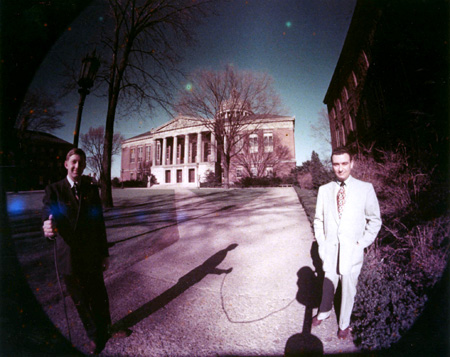Walter P. Siegmund
|
Read more
at in70mm.com The 70mm Newsletter |
| Written by: Walter P. Siegmund | Date: 03.10.2008 |
 Walter
Siegmund (left) and Gilbert Clotar posing for the Bug Eye lens next to
the Baush and Lomb building at the University of Rochester. Note camera
shadow next to Gil. Image thanks to Walter Siegmund. Walter
Siegmund (left) and Gilbert Clotar posing for the Bug Eye lens next to
the Baush and Lomb building at the University of Rochester. Note camera
shadow next to Gil. Image thanks to Walter Siegmund.I was born in Bremen, Germany in 1925 and had one older brother and no sisters. My father left Germany in 1929 to find work in America and the rest of us left for New York just after my fifth birthday. We arrived on September 13, 1930 and left immediately for Rochester, New York. Rochester had a large German-American population, was a center for optical manufacturing and the home of Eastman Kodak Co. I went to public school and upon graduation from high school entered the University of Rochester for the course in optics. A fellow (female) student entered in our "homeroom" attracted my attention (we were seated about 5 meters apart) and when we both took the optics course at the university, we started dating and fell in love at 17! We have been married for 58 years! I served in the US Navy for 13 months and then returned to the University of Rochester for my graduate work. In 1952 after receiving my PhD, I went to work for Dr. Brian O'Brien on a problem in vision. Near the end of 1952 he asked me to join him as an assistant in his new position as Vice President for Research at American Optical in Southbridge, Massachusetts. I said yes. Our first project was to develop a new motion picture system which, as Mike Todd put it, "Cinerama out of one hole". This was a "crash" program for an old-fashioned company like American Optical and eventually nearly 100 engineers and technicians were involved. |
More
in 70mm reading: Walter Siegmund Interview Garrett Brown meets Walter Siegmund at American Optical 4. Todd-AO 70mm-Festival 2008 |
 Most of the attendees here know all they want to know about Todd-AO but
I may be able to still tell a few more "secrets". Most of the attendees here know all they want to know about Todd-AO but
I may be able to still tell a few more "secrets".After the special optical corrective printing process was set aside I returned to the Research Laboratory at AO to take up a new assignment, the development of another of Dr. O'Brien's inventions, "Fiber Optics". The story of this development has many facets and has led to incredible new technologies achieved by laboratories all over the world. My role at American Optical was to lead up to the R & D program which lead to improved night vision devices, flexible imaging cables for space optics and military applications, fiber optic endoscopes, fiber optic magnifiers and medical x-ray imaging components. One of the last programs I worked on was a remarkable flight simulator for the F-16 Air Force fighter aircraft. Upon retirement from the German firm Schott Glass headquartered in Mainz, who had purchased the fiber optics operation in 1986, I went into business with a partner developing and manufacturing fiber optic magnifiers for persons with macular degeneration. These were the best of their type ever produced!. Finally, when we were unable to create a strong market for these magnifiers in the U.S. (but had excellent reception in Germany, Holland and Japan), we ceased production at the end of 1999. Immediately thereafter I set up a new corporation to produce so called "capillary arrays" for neutron imaging devices primarily for the French Atomic Energy Commission. The basic program for which these were required was the production of energy by controlled fusion, the ultimate source energy in the universe! To the best of my knowledge, I was the only one in the world producing these arrays! (in my barn behind our house). When we moved to a new house the entire process was transferred to a small company in Massachusetts and the barn is now filled with horses! |
|
|
Go: back
- top - back issues
- news index Updated 28-07-24 |
|
